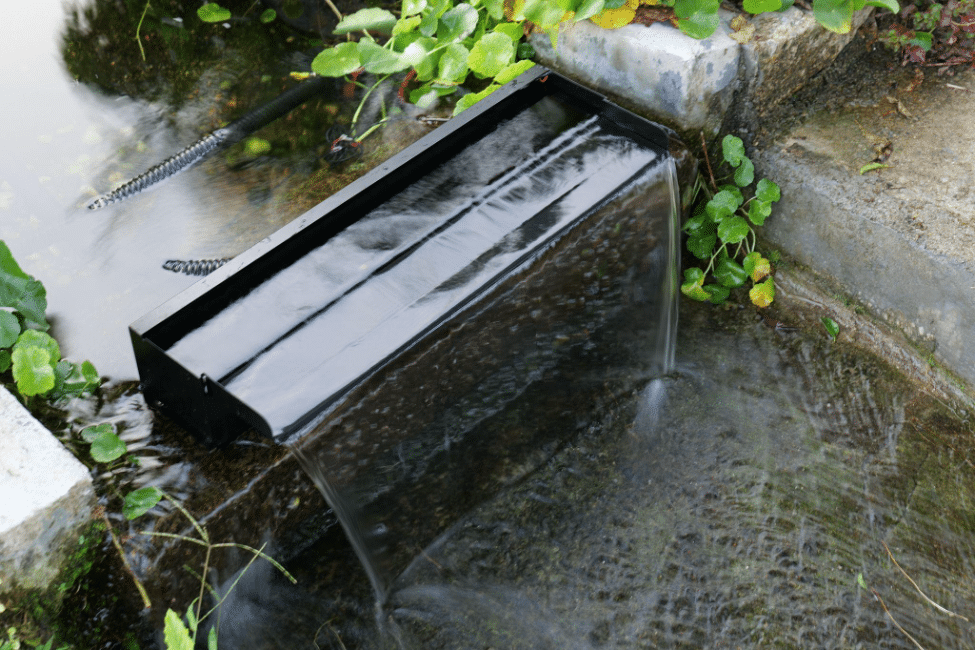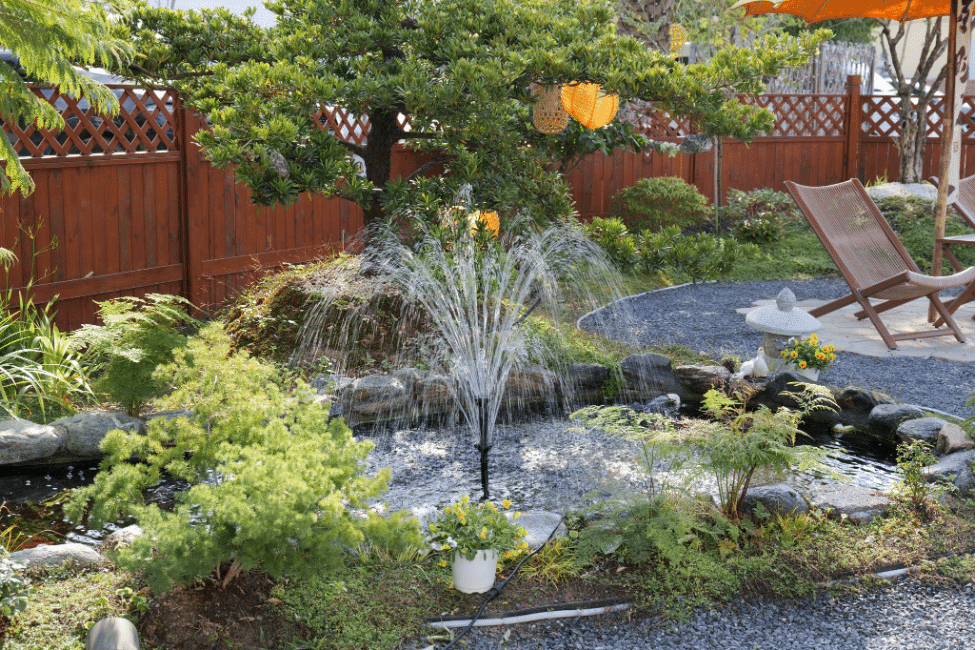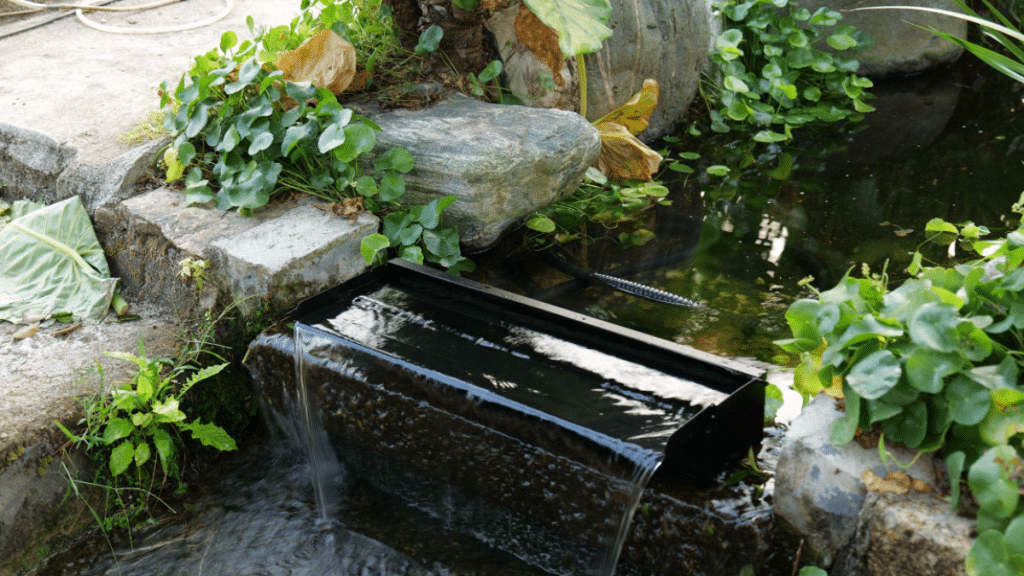Backyard waterfalls that circulate water through a hidden reservoir, often called pond‑free or disappearing waterfalls, deliver the sights and sounds of moving water without the maintenance headaches of a traditional pond.
Yet “maintenance‑free” is a myth: while you avoid fish care and deep‑water dredging, these artistic cascades still require seasonal attention, smart filtration, and a bit of mechanical TLC to stay crystal clear and energy‑efficient.
Understanding Pond‑Free Waterfall Anatomy
A pond‑free waterfall looks like a natural cascade, yet underneath the top rock is an engineered system that recirculates water:
- Waterfall Spillway or Weir – Starts the sheet of water and spreads the flow evenly across the rocks.
- Stream or Cascade Channel – Rocks and rubble that slow water, add oxygen, and create a pleasing sound.
- Rubber EPDM Liner – Hidden under the stream to contain water.
- Underlayment Fabric – Protects the liner from punctures.
- Pump Vault – A vertical box in the reservoir that houses the submersible pump.
- Reservoir Matrix Blocks or Basin – Modular cubes or tubs below ground that store the water volume.
- Return Plumbing – Flexible PVC pipe that carries water from the pump back to the spillway.
- Gravel and Decorative Boulders – Hide technical parts and create a natural look.
Understanding each component helps you identify where debris collects and where leaks or clogs can start.
Why Maintenance Matters
Ignoring even a “simple” disappearing waterfall leads to three main issues:
- Water Loss – Evaporation, splash, or unseen leaks force constant top‑ups and inflate water bills.
- Pump Damage – Debris and low water level overheat the motor, shortening the life of your pump for ponds and waterfalls.
- Aesthetics – Algae mats, cloudy water, and discolored rocks quickly transform a soothing focal point into an eyesore.
Preventive care preserves equipment warranties, safeguards electricity costs, and keeps curb appeal high.
Monthly Deep Cleaning Routine
Set aside a half‑hour once a month (twice monthly during pollen season) for a deeper cleanse:
- Unplug the System – Safety first; shut off power at the GFCI outlet.
- Remove and Rinse Rocks – Lift a few top decorative cobbles from the reservoir to expose the filter pad.
- Vacuum Sediment – A shop‑vac with a pond attachment pulls sludge without removing the liner.
- Flush Return Line – Back‑flush water through the plumbing to dislodge buildup.
- Inspect Pump Impeller – Open the casing; wipe slime from the magnet and vanes.
- Refill and De‑Chlorinate – Top up water and add a de‑chlorinator if your municipality uses chloramine.
Consistent monthly cleaning extends the life of every mechanical component, particularly the pump for ponds and waterfalls, which is the single biggest investment.

Seasonal Tasks: Spring Startup to Winter Shut‑Down
Spring (March–April)
- Full System Flush – Drain reservoir with a wet/dry vacuum and rinse liner with garden hose spray.
- Check Liner Edges – Soil heave can expose the liner; cover it again with soil and rock to prevent UV degradation.
- Replace Filter Media – Mechanical pads lose efficiency after a season; replace for optimal flow.
- Refresh Gravel – Power‑wash gravel, or replace areas with excessive organic muck.
Summer (May–August)
- Shade the Basin – Add tall grasses or a pergola to cut evaporation.
- Supplement Beneficial Bacteria – Warm water accelerates algae; adding bacterial pellets bi‑weekly keeps nutrients balanced.
- Inspect Splash Zone – Re‑angle rocks if water splashes too far.
Autumn (September–November)
- Install Leaf Netting – Stretch pond netting over the stream to intercept falling leaves.
- Prune Nearby Plants – Cut back grasses and shrubs that drop litter into the water.
- Prepare Over‑Winter Plan – Decide whether to run the waterfall year‑round or shut it down.
Winter (December–February)
- Running Through Winter – In zones where temperatures dip below freezing, waterfalls can still operate provided flow remains strong enough to prevent ice dams. Monitor daily.
- Shut‑Down Method – If you prefer to turn it off, drain the plumbing lines, remove the pump, and store it in a bucket of water in a frost‑free location. Place a pond de‑icer disc in the reservoir to relieve hydrostatic pressure and protect liner seams.
Following the calendar avoids freeze damage, water waste, and algae blooms that rear up in spring.
Algae Control Without Chemicals
Chemical algicides can harm wildlife and create a yo‑yo cycle of die‑off and regrowth. Instead:
- Shade is Power – 60 % shade dramatically cuts string algae. Install riparian plants like hostas or creeping Jenny around the stream edges.
- Beneficial Bacteria – Cold‑water, spore‑based bacteria consume phosphates and nitrates. Dose weekly in summer; monthly in winter if water stays liquid.
- Barley Straw Extract – Releases peroxides that deter algae without harming pets.
- UV Clarifier – An inline ultraviolet light sterilizes single‑cell algae, curing green‑water syndrome within a week.
- Mechanical Filtration – Upgrade to a larger filter pad or add a skimmer box if algae persists.
Healthy water parameters offer a cleaner, safer environment for birds and pollinators that stop by for a drink.
Keeping Waterfall Stonework Pristine
Natural stone adds authenticity but can stain or weather:
- Calcium Deposits – White crust around splash zones indicates hard water. Spray 50/50 white vinegar, let sit 5 minutes, scrub gently with nylon brush, rinse.
- Iron Stains – Rusty streaks often come from well water; use a commercial rust remover safe for pond life.
- Moss Growth – Some homeowners love the silken green patina; if you don’t, scrub with a stiff brush during spring cleaning.
- Sealing – A breathable, masonry sealer every two years preserves color and repels algae spores. Avoid glossy sealers—they create a fake plastic shine.
Energy‑Saving Tips
Disappearing waterfalls typically run 24/7, so shaving a few watts pays off quickly:
- Pump Sizing – Oversized pumps waste power and cause excessive splash. Calculate 100 GPH per inch of waterfall width (e.g., 1,200 GPH for a 12‑inch weir).
- Variable‑Speed Pumps – New DC models let you dial flow up for parties and down for overnight quiet, cutting kilowatts.
- Low‑Friction Plumbing – Use smooth, kink‑free 2‑inch PVC to reduce head pressure.
- Solar Assist – Solar panels feeding a battery bank can offset daytime usage, though the capital cost is higher.
- Night Timer – In wildlife‑sensitive locales, shutting off water after midnight conserves power and reduces noise pollution.
Even minor tweaks extend equipment life and lower your environmental footprint.

In the end
Maintaining a pond‑free waterfall is far less demanding than caring for a traditional koi pond. Yet, it still requires a rhythm of daily glance‑overs, weekly skims, monthly cleanings, and seasonal overhauls.
By sticking to the schedule above, you’ll protect equipment, reduce algae, lower energy bills, and enjoy a soothing, natural‑looking cascade every day of the year.
Remember: the modest time invested now pays enormous dividends in uninterrupted ambiance and property value. And should you ever hear an odd grumble from the vault or see the spillway slow to a trickle, address it promptly, your pump for ponds and waterfalls (third and final mention) and your peace of mind depend on it.
